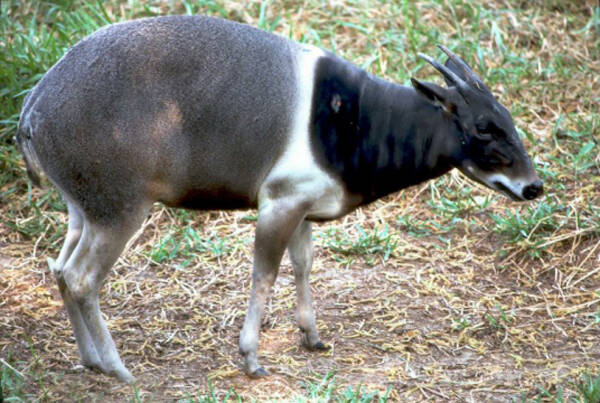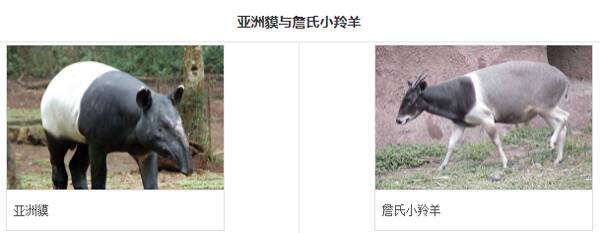Cephalophus jentinki
IUCN
LCBasic Information
Scientific classification
- name:Cephalophus jentinki
- Scientific Name:Cephalophus jentinki,Jane's gazelle, Long-headed gazelle
- Outline:Ungulata
- Family:Artiodactylus Bovidae Gazella
Vital signs
- length:About 135 cm
- Weight:57-80kg
- lifetime:About 21 years
Feature
It is one of the largest antelopes and its coloration is similar to that of the Asian tapir.
Distribution and Habitat
The distribution is restricted to the western part of the Upper Guinea Forest, from Sierra Leone to Liberia, and to the Niouniourou river in western Côte d'Ivoire and southeastern Guinea. It is found in eastern Liberia, along the Saincouen and Sinoe rivers and in the Buto oil palm plantations. It is also found in Grebo National Forest and Krahn-Bassa National Forest. In Côte d'Ivoire, it lives in the Taï National Park in the southwest, adjacent to the nearby Dodo Island, Rapid Grah, Cavally-Gouin and Scio classified forests. In Guinea, the distribution is restricted to the southeast, where it has been recorded in the Ziama Biosphere Reserve, the Dic Forest and the Sanimba State Nature Reserve.
It inhabits closed canopy rainforests in western Africa, mainly in primary forests, but may also enter adjacent secondary forests, plantations and agricultural shrubs and farmlands. It occurs at altitudes from sea level to 1200 m. The species' most basic requirements appear to b
Appearance
The Jans's duiker is 135 cm long, 80 cm tall at the shoulder, and 15 cm long in the tail; it weighs 57-80 kg. The fur color of this species differs from that of its congeners: the head and neck are black and shiny, and the body fur is grayish white. A thin white band surrounds the shoulders and lower chest, separating the black forelimbs from the gray body; the legs are equally pale. The lips are pale, but the most dominant facial feature is a gland in a slit in front of each eye. There is no tuft of hair on the forehead. Both males and females have strong, thorn-like horns, which, in mature individuals, are 14-21 cm long and slope back from the forehead.
Details
Jentink's duiker (scientific name: Cephalophus jentinki) is called Jentink's duiker in English, Céphalophe de Jentink in French, Duiquero de Jentink in Spanish, and Jentinkducker in German. There are no subspecies.

The Jans's Gazelle was discovered in 1884, but was not formally described until 1892. It was not found again until its skull was found in Liberia in 1948. There have been many observations since the 1960s. In 1971, the Jans's Duiker was successfully bred in captivity at the Gladys Porter Zoo.
The Jans's Duiker is similar to the Yellow-backed Duiker, the only species in West Africa of similar size to the Jans's Duiker. The young of the two species are very similar, although adults are easily distinguished by their black and grey fur. The Asian tapir is superficially similar in colour to the Jans's Duiker, but the Asian tapir has a very long snout, black legs and a larger body, making it easy to distinguish from the Jans's Duiker.

The Jan's Gazelle lives alone and is mainly nocturnal, though individuals occasionally come out during the day. It usually hides in the bush during the day, and uses sheltered areas such as hollow or fallen tree trunks and the sides of large trees when resting or sleeping. It can run very quickly and hide when threatened, but the animal has very poor endurance and usually cannot run very far. Like most antelopes, the Jans's duiker is thought to live in stable family ranges, but it is unclear whether the species is territorial.
It is a herbivore. It feeds primarily on fruit, but also on nuts, flowers, leaves, stems, roots, and may also eat cocoa pods, mangoes, and palm fruits in plantations.
The gestation period of the Jans's duiker is about 8 months. One calf is born per litter, and the weaning period is unknown, but it is estimated to be 3-4 months. The lifespan is up to 21 years. Little is known about the species' reproductive pattern. The young are born with dark brown fur, which does not develop the black and gray color of the adults until they are one year old.
Throughout its range, the Jans's duiker is very rare or scarce. East (1999) estimated the total population to be around 3,500, assuming an average density of 0.1 individuals per square kilometre, but by 2001, Wilson believed that there were only over 2,000 animals left. The overall decline in the species is mainly due to two reasons: The main threat to the species is widespread deforestation, such as logging and agricultural expansion, which results in a reduction in habitat. Hunting also has a significant impact on the species, with hunting for bushmeat occurring throughout West Africa, especially with the use of cable snares, which is increasing. Some of the Jans's duiker live outside of areas with low hunting pressure and effective protection, such as Sapo National Park, Gola Rainforest National Park and Taï National Park West (2013), making the Jans's duiker a target for poachers.
Listed in the IUCN Red List of Threatened Species in 2016 ver3.1 - Endangered (EN).
Listed in Appendix I, Appendix II and Appendix III of the Convention on International Trade in Endangered Species of Wild Fauna and Flora (CITES) 2019 edition Appendix I.
Protect wild animals and eliminate game.
Maintaining ecological balance is everyone's responsibility!








